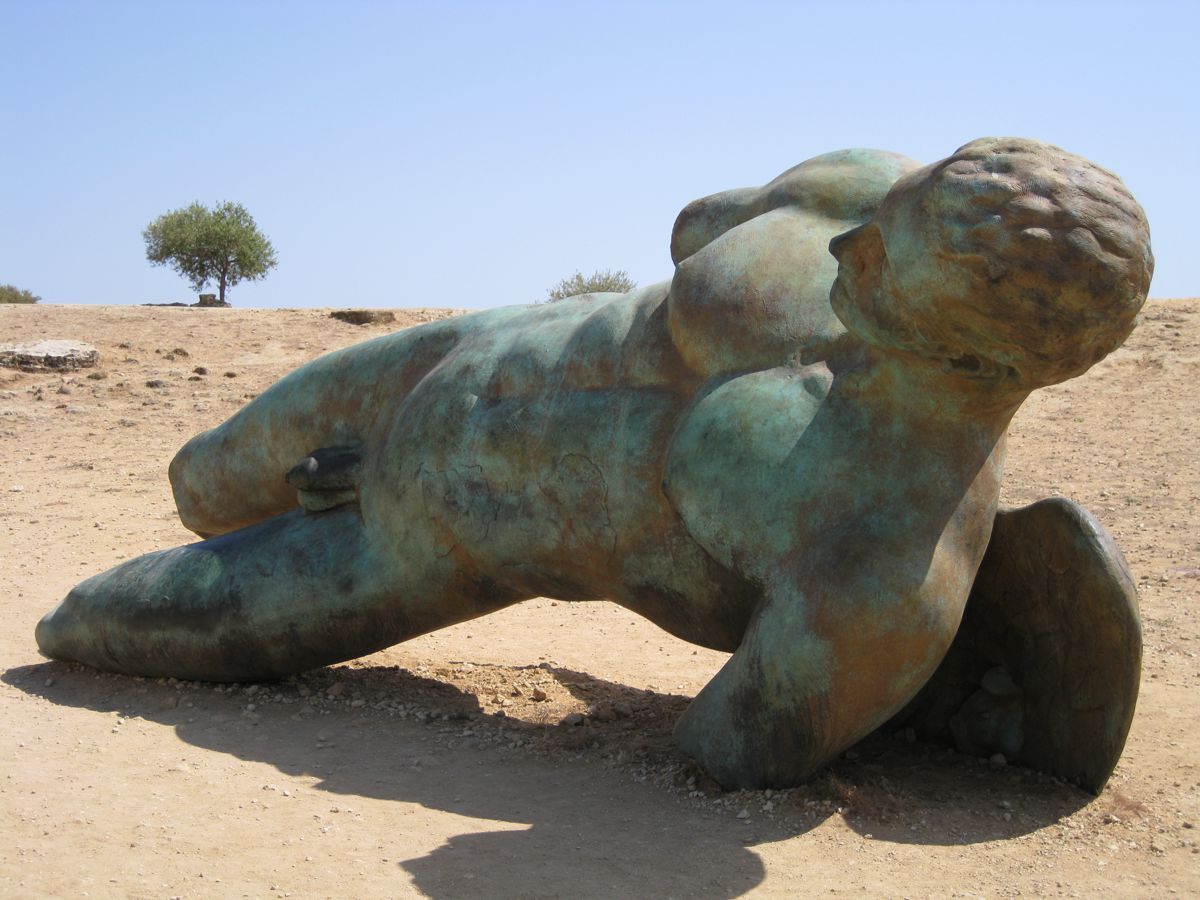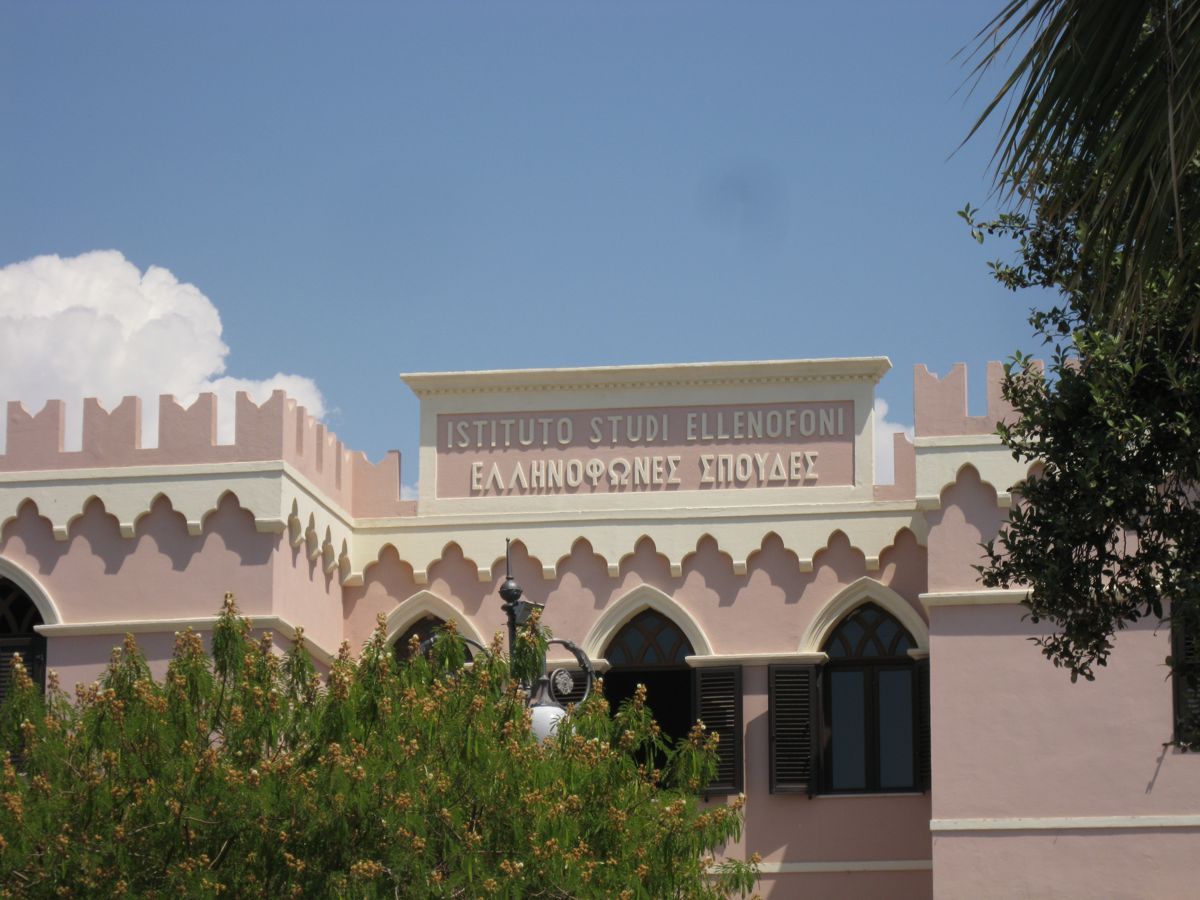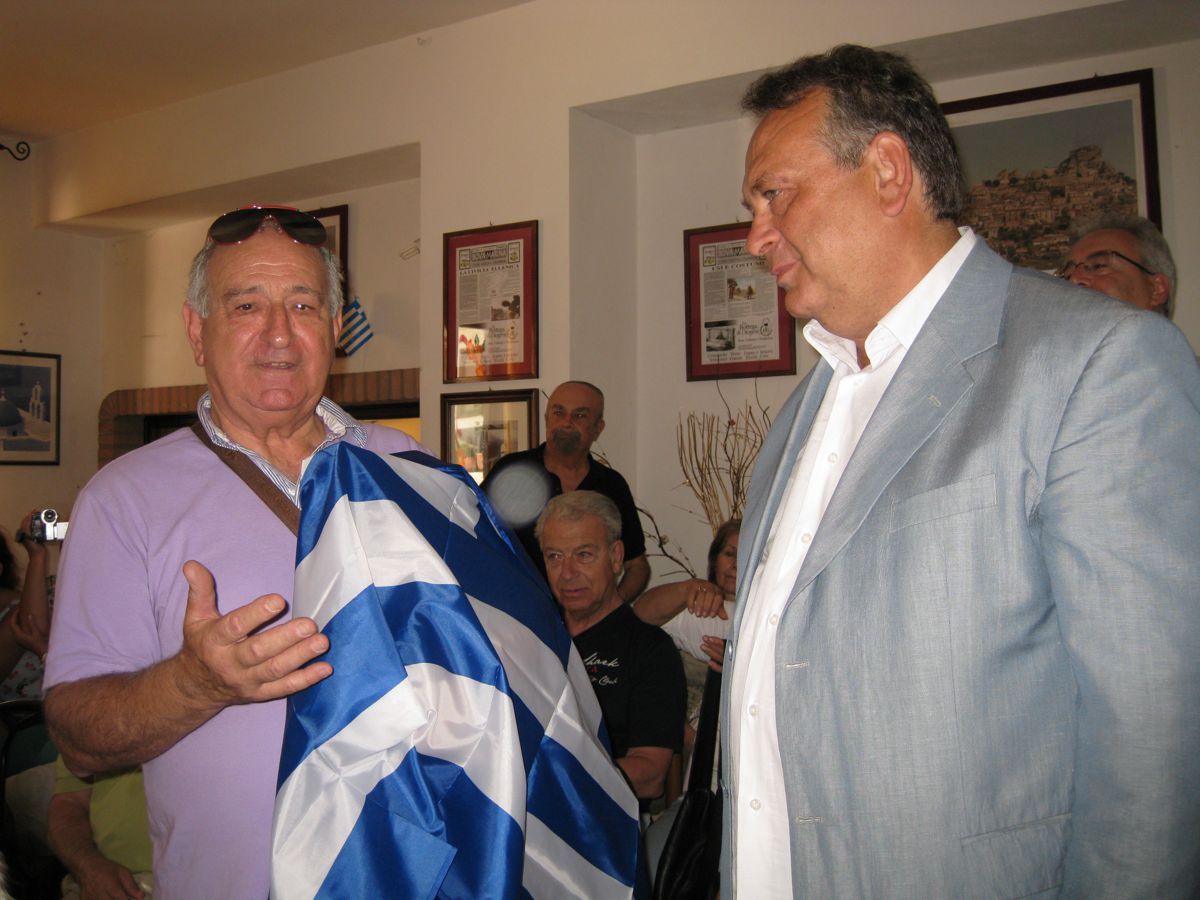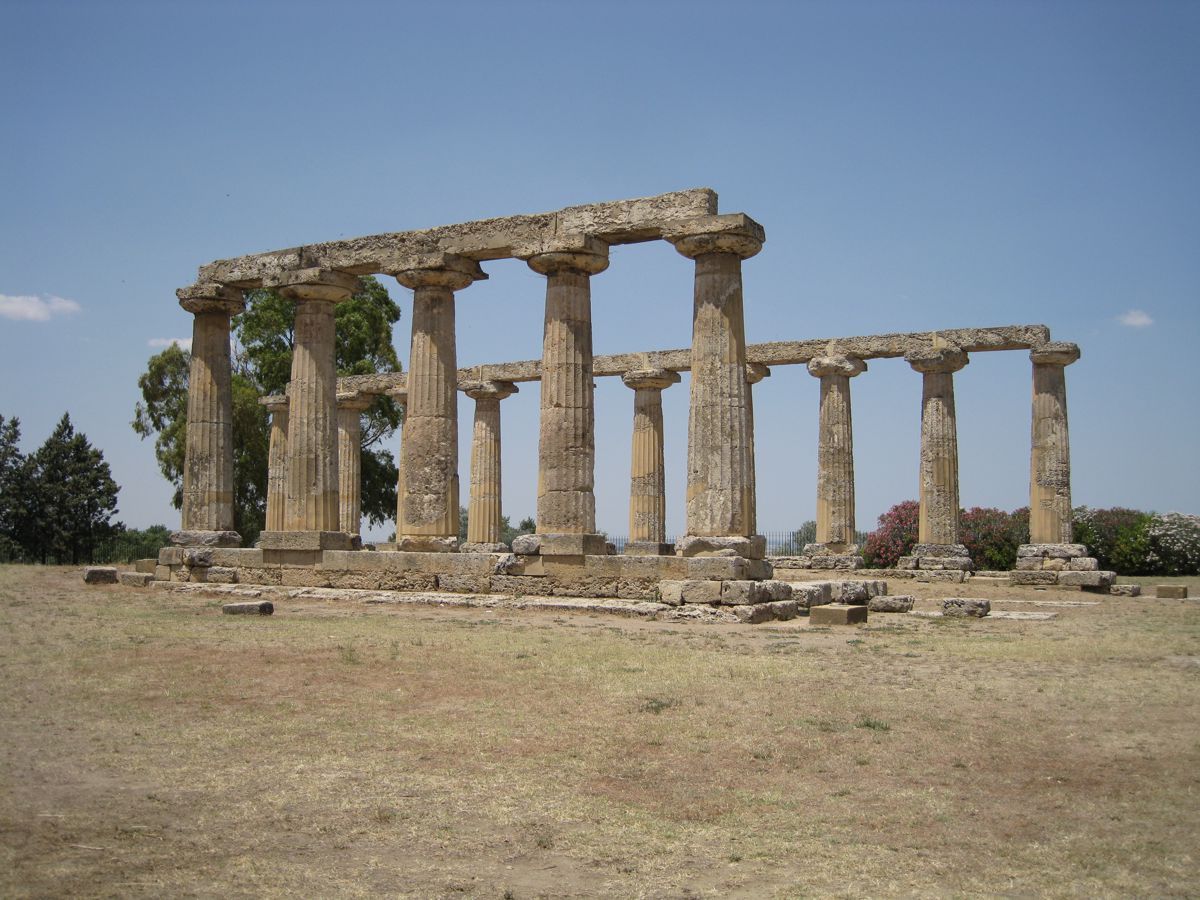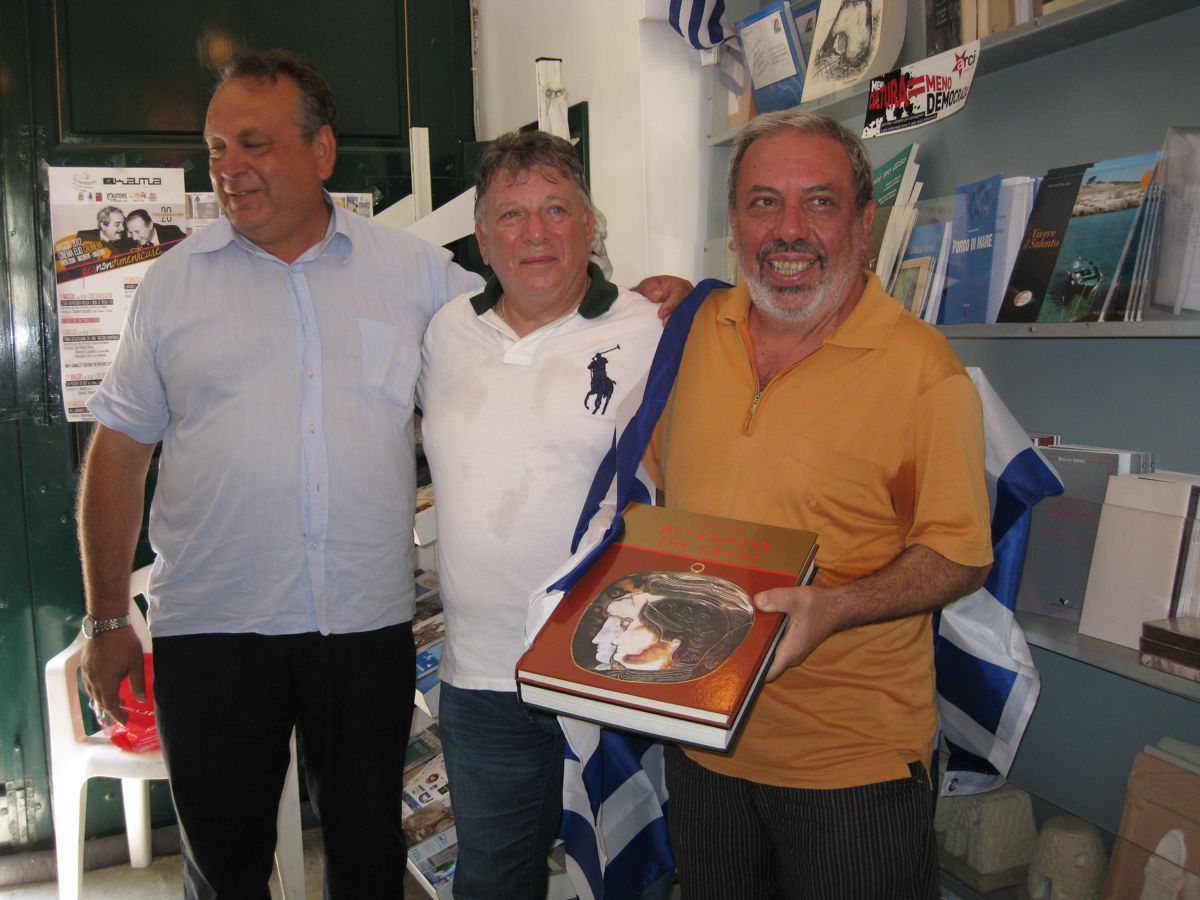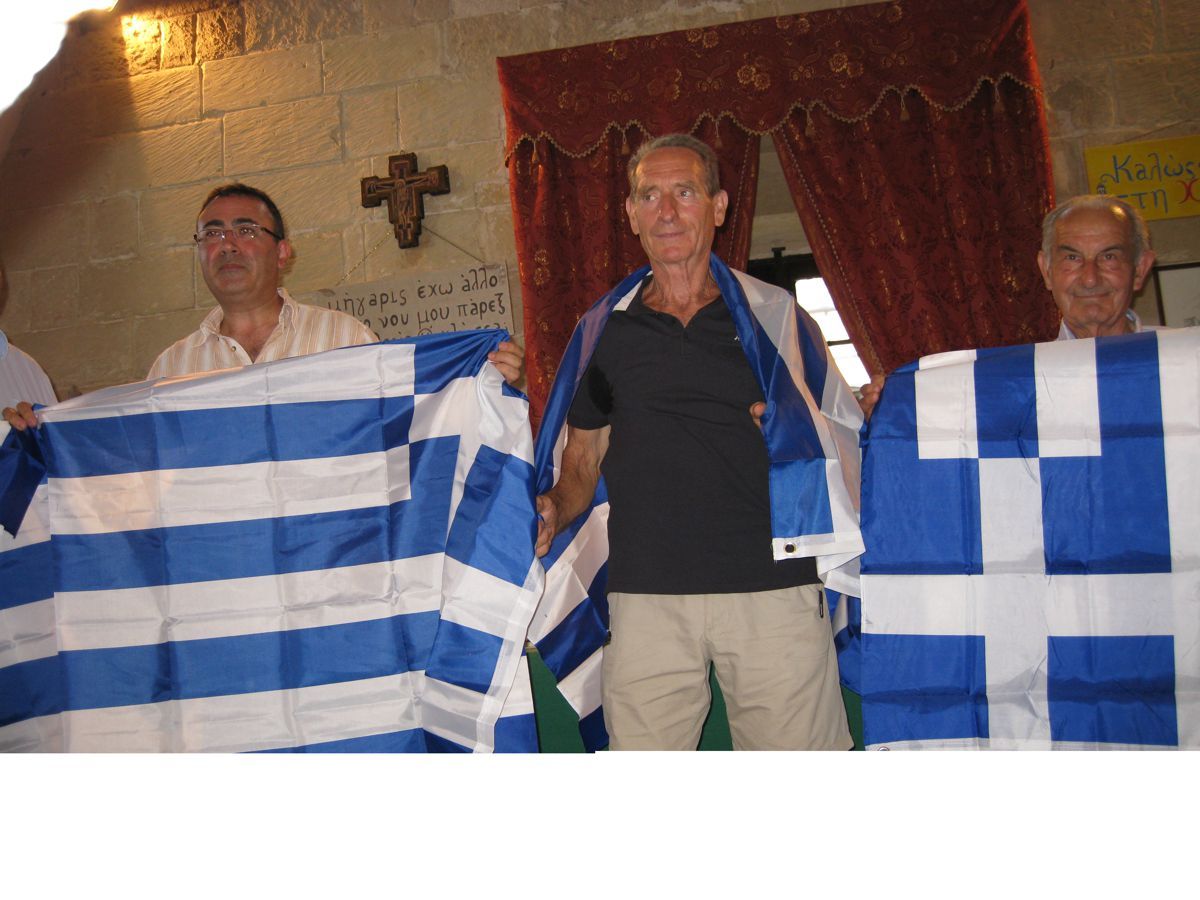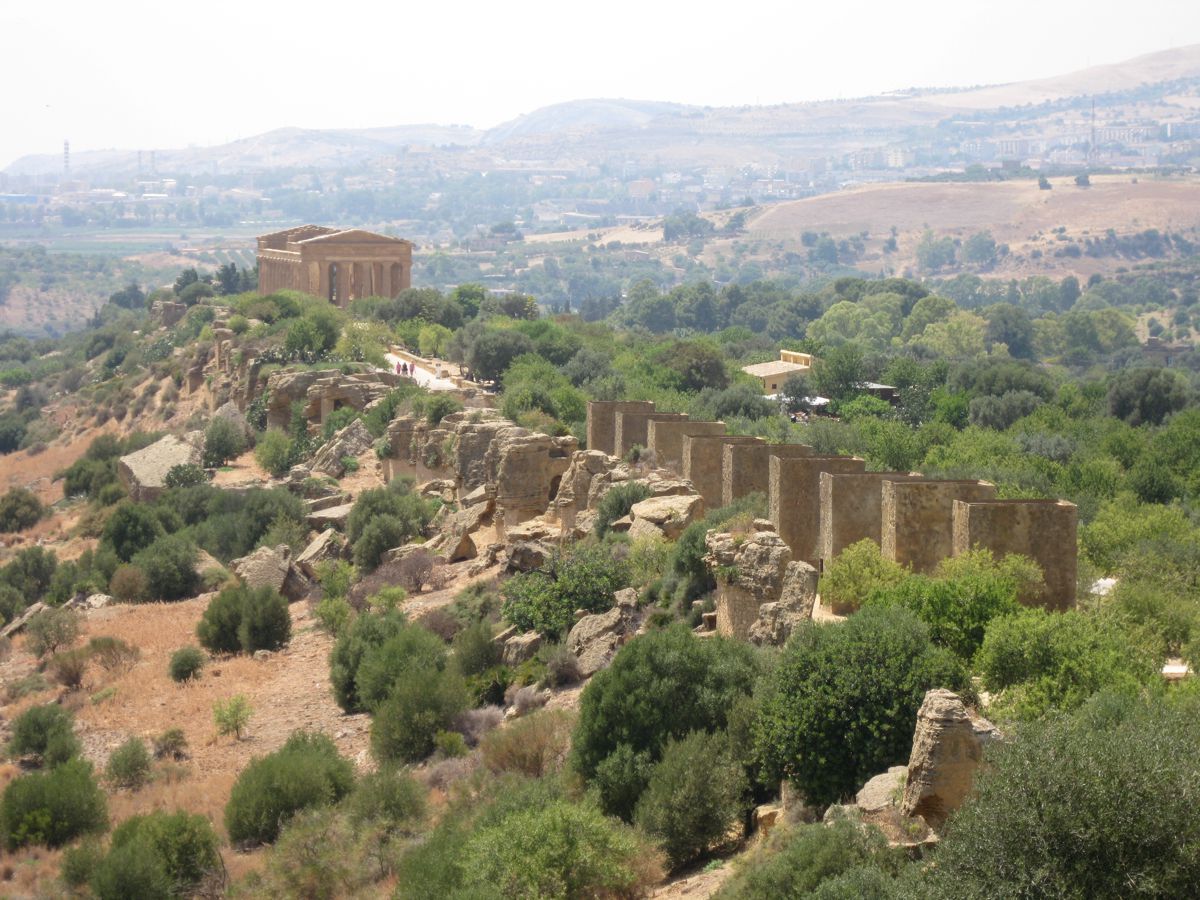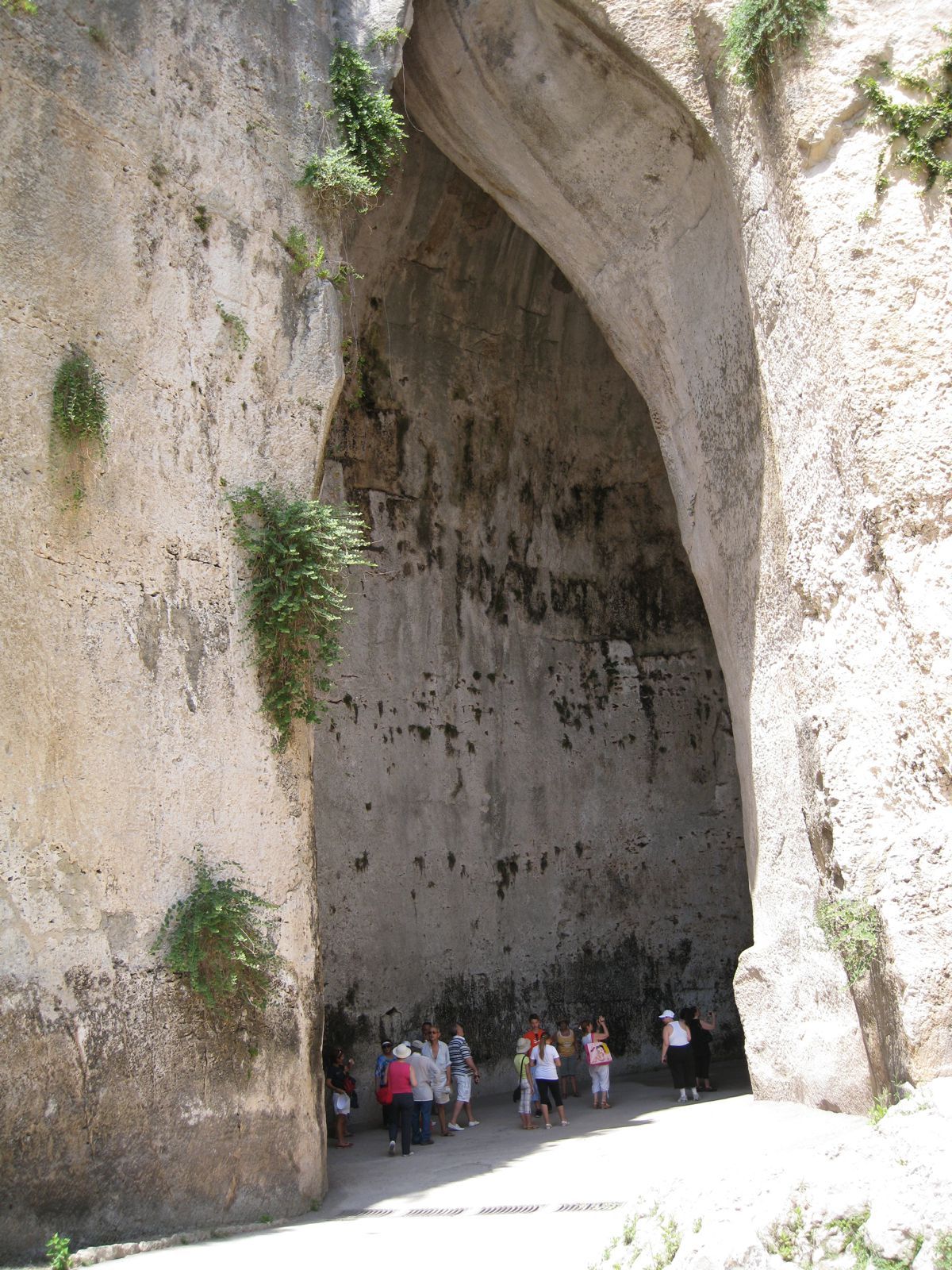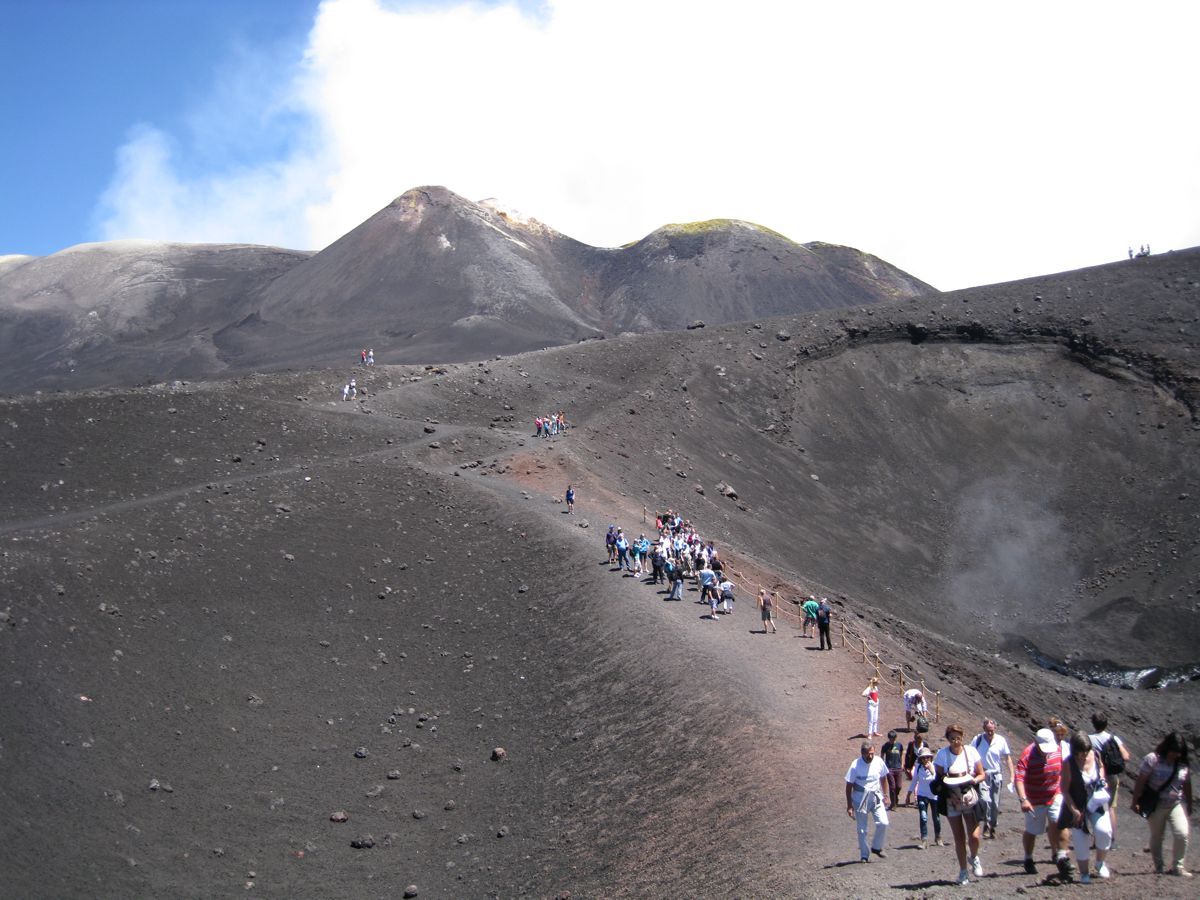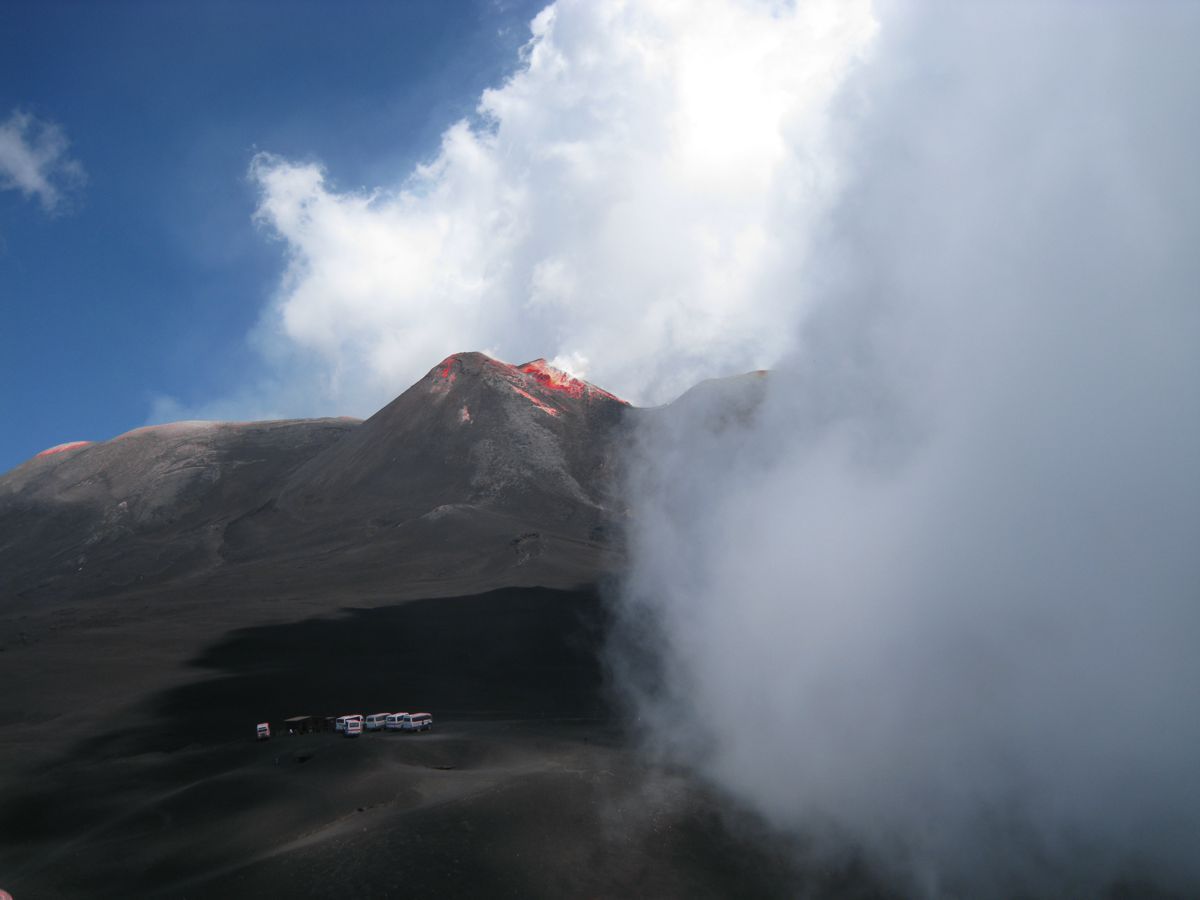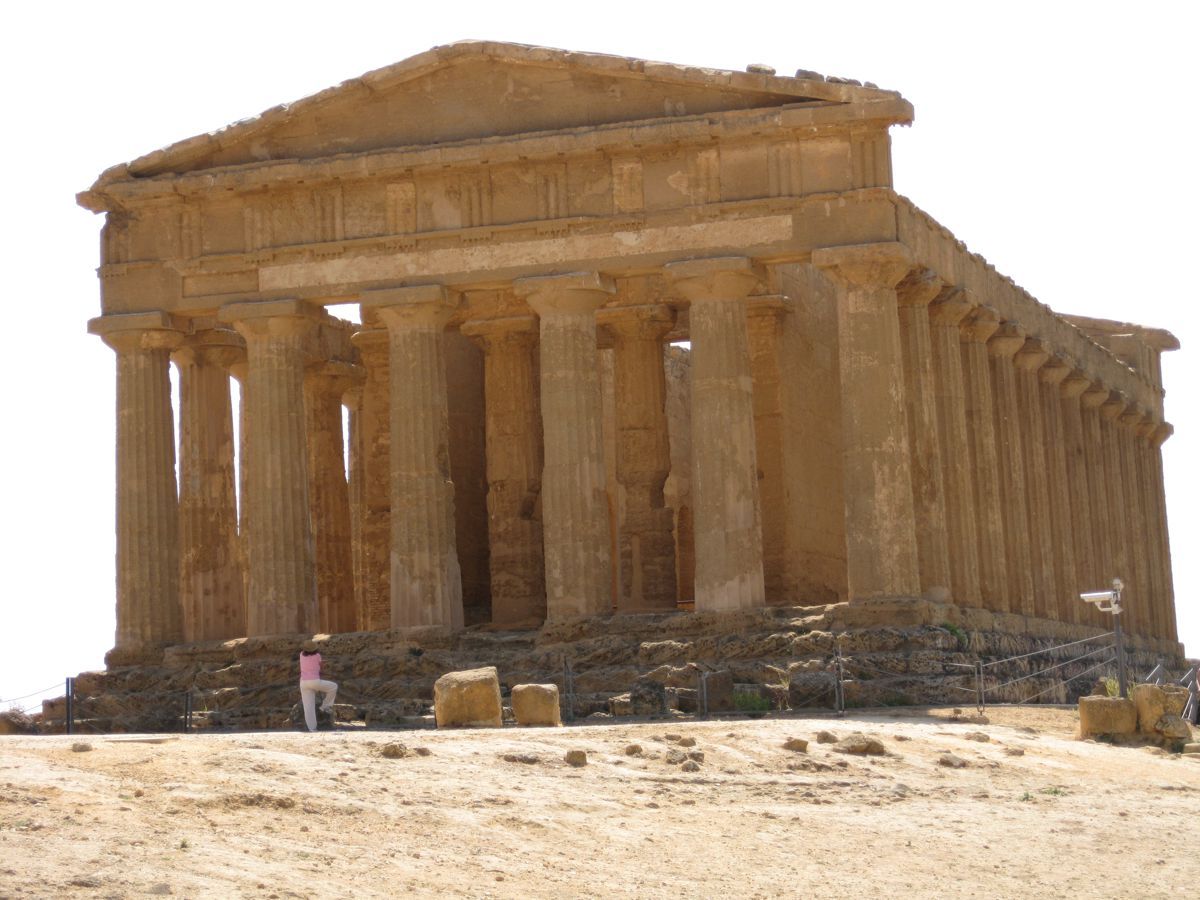Mission to the Greek speaking villages around the world
(June 29th – July 9th 2012)
Trip to South Italy and Sicily, Palermo, Selinoundas, Akragas, Syracuses, Catania, Messini.
We visited the Greek speaking villages, met the Greeks and their history, we admired the dynamics of the ancient Hellenic culture and walked throughout the castles of the Byzantium and the middle Ages.
90 of our members participated from around the country.
“We are the Greeks!” That’s what the Greeks of Great Greece answered at the question “Are you also Greeks?”
This mission was carried out under very difficult circumstances. With a temperature of 40 to 45 ° C, humidity up to 80% and the President of the Program Universal ill throughout the whole Mission, this trip was the most tedious so far. The distances covered under these conditions seemed endless to the companions, but what they saw and felt when visiting the Great Greece surely overshadowed everything else. Fifty-six members, collaborators and friends of the Ecumenical Hellenism, participated in these difficult times of our country in the mission and the big meeting with our Greek-speaking brothers and sisters in Calabria and Apulia. They traveled to historical places on the tracks of the ancient Greeks – settlers of southern Italy and Sicily.
Leaving behind the port of Patra and then Igoumenitsa on the morning of June 29th, we started this unique 11-day trip to the lively traces of Greater Greece and the Greek Orthodox world in southern Italy and Sicily.
Shrines – monuments – centers, visited by the mission
Bari, the capital of the region of Apulia, with its unique old medieval city. Graphic, narrow, paved streets with various shops and local cafes that relaxed us after our pilgrimage to the Romanic and Gothic age royal Church of St. Nicholas. The interior consists of the hall and two corridors and is divided by granite columns and pilasters. This Church was the first of this design, setting a precedent, later imitated in many other structures in the area. The Church hosts one of the most remarkable Romanesque sculptures of southern Italy, the Episcopal throne of Elias, the first archbishop. There are precious mosaic floors in the crypt and the presbytery. The crypt, the oldest of the area, is also decorated with mosaics. The crypt, with 26 columns, houses the relics of St. Nicholas.
Our next stop was the Metapontum, where we saw the archaeological park with the temple of Lakinia Hera, and then Rigio at the nose of the Italian “boot”. There we visited the Museum of Great Greece, whose main exhibits are the Dioscuri, the paintings of the Locri, the antiquities and the brass warriors of Riace.
Bova Marina, Calabria’s headquarters where we were warmly welcomed by professors from the Greek-speaking Institute and informed from local actors and Greek speakers. The two-volume project “Thrace – History – Culture” and “Alexander the Great” were presented by the President of the Foundation of Ecumenical Hellenism and given for their library, as well as Greek flags. We dined together and talked in the local dialect and groups of Greek-speaking children, dressed in their traditional costumes danced in honor of us with the accompaniment of live traditional music, with temperature conditions above 40 oC.
Passing through the narrow streets of Messina (Skylla and Charybdis to Homer), we stopped in the beautiful medieval Kefalou with the small, picturesque streets, we saw the Byzantine mosaics in the church of Rogiros and visited the medieval laundries.
Palermo, the capital of Sicily, the city of contrasts and various characters. Old and new, well-built and ruined, alive and dormant, Christian and aloof, you see everything there, except Greek antiquities. The Normand element prevails, especially the metropolis, but the baroque era is not left behind. There are Churches everywhere with elegant bell towers and statues at the central gates and ornate windows. Piazza Pretoria and the Praetorian Hall, the Norman Cathedral and the tombs of the Kings, Martorana with the Byzantine mosaics and the famous Duomo of the neighboring Monreale, with the most mosaics (6,350 sq. M.) after Saint Sophia, are in the center of our attention. It is built in a magnificent location, at the depth of the great bay of the northwest coast of Sicily, at the foot of Mount Pellegrino, in a fertile valley. It is a city with ancient history. It was a colony of the Carthage, while the Phoenicians and the Greeks used it as a station on their journeys. It was conquered by the Romans, the Normans, the French, the Spaniards and the Arabs. During our stay in Palermo, a visit was fulfilled to the catacombs built in 1599 by Capuchins (monks) to be used as capuchin catacombs.
However, in the following centuries it became a symbol of a social position in order to place the dead of Palermo’s society, citizens (usually wealthy) in the Capuchin catacombs. They are a spectacular monument of the area, with 8,000 mummified corpses being kept there.
The ancient Selinountas. Selinus was founded in the second half of the 7th century BC on the southwest coast of Sicily as a subsidiary city of the East-Sicilian Doric Colony of Megara Hybla. The city owes its name to the Greek word Selino, which means wild celery, the plant that is rich in the region. It has one of Sicily’s most extensive archaeological parks and a valley with giant temples, the fortification wall, the Acropolis and a place of religious worship, where the ruins of the majestic temples still stun the passenger that walks by and reveals the level of prosperity and wealth of Selinoundas between the 6th and the 5th century BC. There are eight temples here, the most imposing being the one of goddess Hera, while the vast columns of the rest are scattered everywhere, which having as a background the acropolis columns, unwillingly return your memory to the exaltation of Greek colonialism.
Akragas is the jewel of Sicilian antiquities. In addition, Akraga and Selinoundas, compete in number, size, and imposing of temples and offer the record of the total number of ancient temples in the Greater Greece, compared to all the ancient temples in metropolitan Greece. In ancient years Akragas was home to artists, philosophers and great men of history.
It was a rich city with great power and the poet Pindar called it “the most beautiful city of mortals”. The valley of temples in Akragas is a rectangular area of 12 km and is a UNESCO World Heritage site since 1998. The temples of Hera, Heracles, Dioskouros, Zeus and the Thereon monument are the central themes of our tour. The temples were built during the period of the Great Greece and are all of yellow sandstone, which could be cut with a saw! Throughout the valley there are several olive, almond, carob trees and countless prune trees. However, there is almost no shade and most of the tour is fulfilled under the hot sun. The Temple of Castor and Pollex – Tempio di Castore e Polluce or Dioskouros, is the first to meet. Then there is the Temple of Olympian Zeus – Tempio di Giove Olimpico. The temple was supported by the great Telamones and the Atlases that occupied the space between the columns of the peristyle. Then is the temple of Hercules – Tempio di Ercole. In Sicily, Hercules was worshiped as a god and not as a demigod, as in Greece. It is the oldest temple of Akragas and dates back to the 6th century B.C. The Temple of Omonoia – Tempio de la Concordia is located in the center of the temple’s hill and is preserved in excellent condition. Last is the Temple of Hera of Likinia – Tempio di Giunone Lcinia, with 25 surviving columns out of 34 and the best view of the hill and the sea. In the old town we saw the cathedral, the Duomo, built on the ruins of a temple of Zeus. It has a nice view, since it is built on a hill. It’s rhythm is Gothic – Norman of the 14th century.
Syracuse, the largest and most powerful Greek city of the Greater Greece. Cicero called it “the most beautiful and most popular city.” The impressive ruins of the center of the ancient city are a UNESCO’s World Heritage Site. We visited the quarry where we saw the ancient theater, the altar of Hiero and the gallery of Dionysius and then we moved to Ortygia. The historic city center is located on this small island, named after the abundant quail it had. You don’t need a boat to go, because the island is connected to the city by the Ubertino Bridge. We visited the Temple of Athena and the fountain of Arethousa and wandered in the picturesque Straits of Ortygia. Syracuse was not only the economic and political center, but also the scientific and cultural center of ancient Sicily. In the palace of tyrants, the philosophers and poets of the whole Greek world met. Teatro Greco is the Italian name of the ancient Greek theater of Syracuse. From the 5th century BC it has seats for 15,000 spectators and has been carved over the rocky area. During the ancient years, the theater welcomed for the first time, many projects from the greatest dramatic writers of the period such as Epirchamus, Euripides, Aeschylus and others. In 472 BC. “Persians” by Aeschylus was first presented here. Along with the ancient Greek theater of Syracuse there are the famous Quarries. Quarry Del Paradiso is today the largest visited area where you can see a fantastic garden. Here, about 7,000 Athenians captured in the Peloponnesian War, in 413 BC suffered and melted. On the northwest corner of the quarries, Dionysius’s ear opens, the Orecchio di Dionisio, an artificial hollow of 65 meters long, 5-11 meters wide and 23 meters, which shape refers to an ear and which has excellent acoustics. The name was received in 1586 by the painter Caravaggio at a visit of his to Syracuse. Instigated by the opening in the rocks similar to the human ear and due to the acoustic phenomenon, where each sound is increased 42 times, the tyrant Dionysius left the pit to be used as a prison, a certain place for imprisonment, according to a tradition. It is also said that, without looking at the opening at the end of the pit at the top left, there is a hole where the tyrant personally listened to the conversations of the prisoners and the enemies of his state.
In the beautiful city of Catania with its Baroque architecture, we wandered around the city in the small picturesque train. Catania is the second largest city in Sicily after the capital, Palermo. It is a transport hub, a financial center and a campus. In the center of the city is Piazza Duomo with the Baroque-style buildings and the Cathedral (Duomo) built in the 11th century and repaired after the devastating earthquake of 1693. The façade is Vaccarini’s work and inside is the tomb of the composer Vincenzo Bellini, who is loved very much in Catania.
The largest volcano in Europe, Etna. We reached the shelters and the first craters. Approximately 10 people from the group dared and had a thrilling experience, climbing by cable car and then using a 4×4 jeep, something like our own army REO to the central crater. At 2,900 meters, we saw the view of the areas of the craters after the 2001, 2002, 2003, 2006 and 2007 eruptions. We went to the Belvedere area and enjoyed an unforgettable view of the volcanic mountain and the Bove Valley as it is called which is the only place on Earth that resembles Mars. The whole landscape has the characteristic lava and we also saw caves and rivers of dried lava.
The cosmopolitan Taormina with its picturesque cobbled streets and countless shops. Its beauty is breathtaking with its natural balconies overlooking the Ionian Sea. Taormina is the ancient Tavromeni, where the inhabitants of ancient Naxos were evicted and settled after the Syracuse victory. The Greek Theater (Teatro Greco) is the most important attraction of Taormina, not only for its great historical value but also for its excellent location. If you see it, you will understand that this is the most beautiful ancient theater built by Greeks. It is known that the ancient Greeks carefully chose the location of their theaters trying to have a nice view. Taormina combined the beautiful sea views and good acoustics.
Messina. We visited the historic center. We saw the Norman Duomo of the Mother Mary of Gorgoepikoos, the Renaissance Orion’s Fontana, the Flemish bell tower with zodiac circles and allegories. Once again we pass by the Straits of Skylla, and we meet the Italian coast. The journey is fulfilled with stops for rest, purchase of local Calabrian products and food.
On our route we met Taranto, the most powerful colony of the Spartans in the West. Taranto was the only colony of Sparta in Greater Greece. For the best view of the city, we walked along the beach, the heart of the old town. The Città Vecchia, is located on an island separating Piccolo Mare from the Grande. The modern city is located to the north of Lungomare Vittorio Emmanuelle. At the Museo Archeologico di Taranto, we traveled and met a collection of artwork from the Paleolithic to the modern times. Most of them are the results of archaeological excavations in the area. The museum has the world’s largest collection of terracotta, along with a unique array of art such as vases, gold ware, marble and bronze sculptures, mosaics, and more.
Our journey is completed with the Greek-speaking villages of Apulia, Lecce, Otranto, Calimera, Sternate, Alberobello.
Lecce is the capital of the Salento region and the birthplace of painter Antonio Verrio (1639-1707). It is one of the most beautiful cities of Italy and has been included (the only city in Italy) in the list of “Best to Travel 2010” by Lonely Planet, a city that had to be visited in 2010, along with nine others, for the beauty of Its monuments and its historical Baroque center. It has been named “Apulia in Athens” for the grace of its inhabitants towards the arts, as well as “Florence of Baroque” due to the 17th and 18th century architecture and its elaborate monuments built or decorated at the time of the peak of this rhythm. Lecce’s emblem depicts an Oak tree and a wolf. The tree is to represent the oak forests in the land of Otranto until 1700, while the wolf is the link to Roman civilization. Its historical center is surrounded by walls with 3 entrances (doors).
The village of Alberobello looks like a fairytale setting and has been declared by UNESCO as a World Heritage Site. The notorious Poulian dome is scattered in all its provinces, from the outskirts of Bari and Brindisi to Taranto, the most famous Greek city of Magna Grecia, with its more characteristic place of concentration, called Alberobello, the capital of Domes. The construction of the dome is concrete, without many deviations: the building is almost square or rectangular, with walls from 80 cm to 2,70 meters thick, while the roof has the traditional stone conical shape. Of particular interest, are the icons painted with chalk on the roofs, as well as their peaks. Today, the settlement is a strong attraction for tourists, but it has not lost its beauty, its peculiarity and its historical and cultural significance.
During our visit to Sternate we experienced unique moments, as we were welcomed with the sign “Welcome Hello” and residents who spoke the local dialect. The inhabitants of this area are descendants of the Greek settlers who settled in southern Italy and Sicily in the 8th century BC and use a dialect that has its roots in the Greek Doric language but has experienced a different evolution from the Greek Common language. From Graecus in Latin, the inhabitants of Grecia Salendina are called Grikos and their dialect Griko.
At the local association “Geitonia”, Professor and President, Mr. Giorgio Filieri, guided us to their places and talked about the history, language and tradition of Greek-speaking villages. He sang to us in Grikos and the President of the Foundation of Ecumenical Hellenism, the Professor of History at the Aristotle University of Thessaloniki and member of the Ecumenical Hellenism Foundation Mr S. Kakridis gave a speech and the two-volume project “Thrace – History – Art & Culture”, the volume “Great Alexander”, the volume “Holy Pilgrimages – Towers of Orthodoxy” were donated to Mr. Giorgio Filieri along with Greek flags, which were accepted with great joy and emotion. We then traveled to the old underground mills.
The same volumes and flags were handed over from the President of the Foundation of Ecumenical Hellenism Mr. Stavros Panousopoulos and our member, lawyer Markoulakos Ioannis, to the Director of the Folklore Museum, Mr. Sylvano Palamas, who welcomed us and guided us throughout the village of Kalimera and its Museum.
Excellent ending for our trip before our return to Greece from the port of Brindisi, the dinner we had at the Greek-speaking Tavern of the region with excellent local dishes, the four-member musical ensemble of Griko, which was also attended by Professor Giorgio Filieri and young Tarantella dancers. All members of the mission enjoyed, sang and danced carried away by the cheerfulness of the singers and young dancers. The traditional dance of Lower Italy, Tarantella, is connected to the ancient Greek colony of Taranto, which is located in the core of the Greek-speaking villages of Salento. It is associated with a phenomenon called Tarantism. Tarantism was a form of frenzy that they thought was due to the stinging of a spider and that’s why it was called Tarantela pitsika from the pitsikare-bite. The Likosa Tarantula they believed was stinging a person in the fields and to cure someone who was stung, a musical exorcism took place.
On this trip to the land of Apulia, the Ionian Sea and the sun of Salento, we experienced the most moving and beautiful moments. One more trip was over. Tired physically, but spiritually turned up. After a trip to Sicily, Goethe said: “Sicily and Great Greece make me hope for the regeneration of life.”

